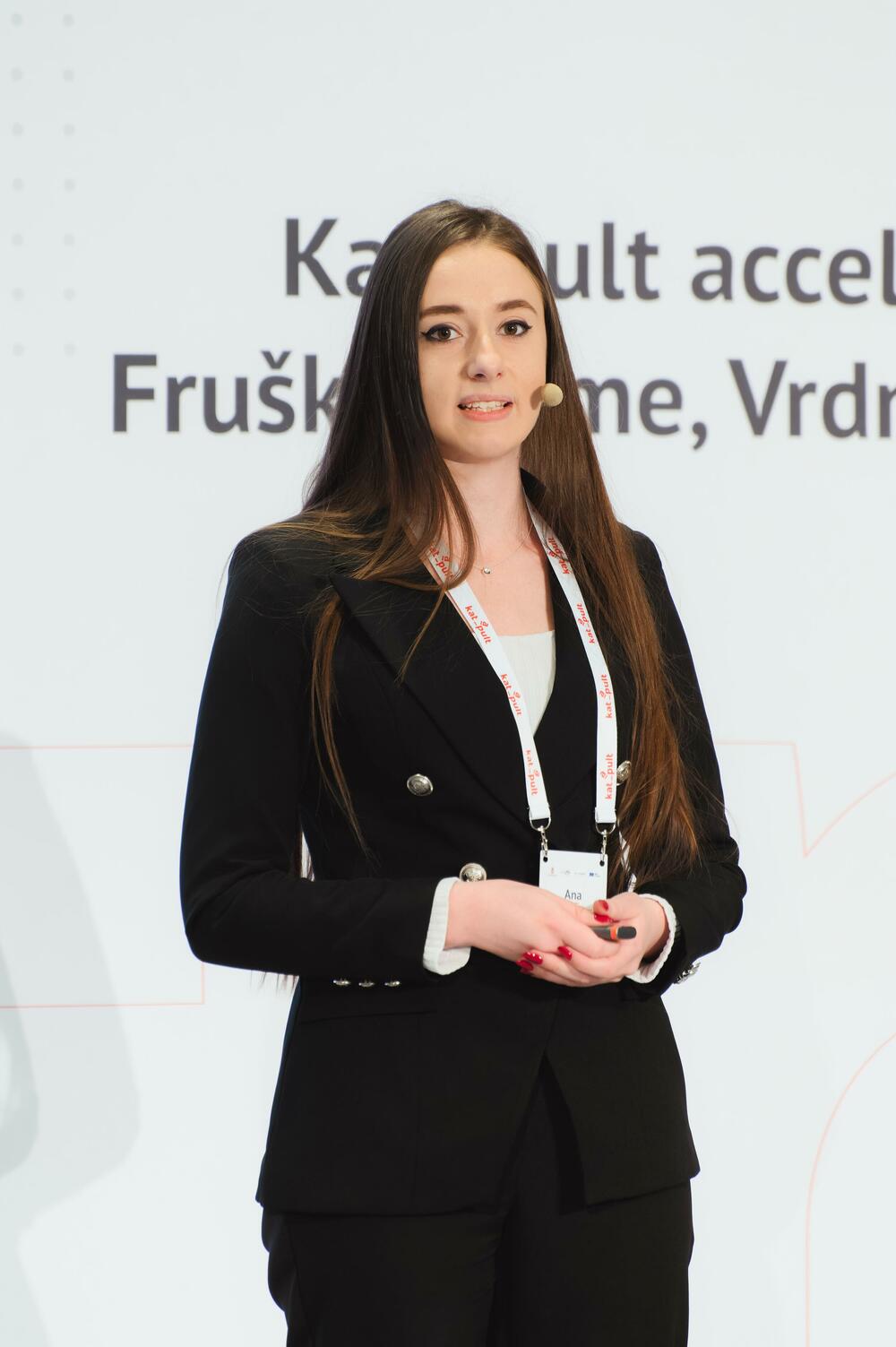The early fire detection software developed by the Montenegrin startup company Spectro Solutions was used last summer to detect fires in Gorica, Podgorica, Luštica, in the municipality of Tivat. other cities are also interested in the same software, and the Spectro team has meanwhile started a new project - securing landfills against fire. This year, they will do a pilot project in cooperation with "Deponia" from Podgorica.
He heads Spectro Solutions Ana Ashanin, and she is one of the girls involved in the development of systems that use artificial intelligence (AI) and machine learning, with the aim of contributing to the preservation of the environment. They work with her on similar projects Itana Bulatović i Sanja Scepanovic.
On the occasion of Earth Day, which is celebrated on April 22, but also the Day of Girls in ICT, which is celebrated on the last Thursday in April, with the aim of spreading awareness among girls about the importance of information and communication technologies, they talk to "Vijesti" about their work and how AI and similar technologies contribute to the preservation of the environment.
Urban vitality, tree map...
Sanja Šćepanović is an AI Research Scientist at Nokia's Bell Labs Institute in Cambridge, United Kingdom, and is part of the Responsible Artificial Intelligence team. She completed basic studies in mathematics and computer science at the University of Montenegro, master's and doctoral studies in the field of data science and complex systems at the universities of Tartu, Estonia and Aalto, Finland. Among other things, she worked at the start-up SEVEN Networks, which deals with mobile technologies, in Silicon Valley, and another, ICEYE, which deals with satellite development, in Helsinki, Finland...
At Bell Labs, she explains, she is part of a team that researches various aspects of responsible artificial intelligence - from how to use this technology for a healthier, more equitable and sustainable urban environment, to studying how its development and use can have unforeseen consequences on individuals and on society...

As an example of the use of AI, Sanja published a study that showed that by applying machine learning methods to satellite images of the Sentinel-2 satellite (which is part of the Copernicus program of the European Space Agency, whose data is publicly available), the "urban vitality" of different neighborhoods in the city can be assessed. .
"Urban vitality is a concept defined by a famous urban theorist Jane Jacobs 70s of the last century. She studied why different parts of American cities have different quality of life and concluded that the following four elements of urban structure are necessary for vital neighborhoods: diverse land use (a mix of residential buildings, green spaces, and commercial spaces), small blocks (vs. wide boulevards), a mix of economic activities, and the concentration of people. Her theory could not be verified before the so-called big data became available," explains Šćepanović for "Vijesti".
Her study is one of the first to empirically confirm Jane Jacobs' theory.
"The significance of the study is that it shows how publicly available satellite images can be used for urban planning and sustainable development," she said.
Itana Bulatović is a machine learning engineer and works at MGGP Aero in Poland, in the research and development team for remote sensing. She completed her undergraduate studies in computer science and mathematics at the Sorbonne in Paris, and is currently completing her master's studies in intelligent systems and robotics at the Chinese University of Shanghai Jiao Tong, where she is engaged in research into the application of deep learning models for the analysis of mammographic images, i.e. detection of breast cancer.
Itana is also one of the founders of the NGO Montenegrin Association for Artificial Intelligence - MAIA.
The company MGGP Aero, where he works, deals with the creation and analysis of aerial photographs, as well as satellite images, based on which they create solutions for mapping and analysis of urbanized space and the natural environment. One such solution is the Digital Tree Map, created from airborne imaging, and analyzed using an AI model.
That map of trees is something like a green cadastre of the Capital City of Podgorica.
"We are aware of the value of green infrastructure and its key importance for adapting to climate change. If we want to manage ecological assets responsibly, we need to know what ecological inventory we have and where. That's why cities order tree inventories and send field workers to streets and parks. However, this type of data collection is time-consuming and expensive. Thus, urban databases are often very limited, incomplete, not up-to-date and the level of error is usually unknown. These challenges are successfully solved by the application of AI in combination with airborne footage," she said.
Artificial intelligence models, according to her, can process huge (size in terabytes, TB) amounts of data, obtained from various sensors - cameras, LIDAR, hyperspectral cameras... much faster and more precisely than a human could do it manually.

"Airplanes (or drones, depending on the surface of the area of interest) with mounted cameras and various sensors, cover the intended trajectory and generate hundreds of images per second. Then, using photogrammetry methods, orthophoto maps are created with precise geodescriptions of cities, urban areas or national parks. The created maps are further used as training data for deep learning models, which learn to recognize certain objects and extract a large amount of information in a very short time," explains Bulatović.
Through the "Digital Tree Map" in Warsaw, where she currently lives, she adds, an area of 517,24 square kilometers was processed, where more than seven million tree tops were detected, with a total area of 182,31 square kilometers.
"Within this project, AI models were used in image processing in the following ways: detection and delineation of individual crowns, then assessment of height and density of crowns, classification of species (evergreen and coniferous trees, but of specific species), as well as assessment of 'health ' canopy. For all this, precise maps have been created that can serve cities for further analysis and decision-making, as well as informed urban planning. Witnessing the effects of climate change, it is worth having and using such a tool, which can help to maximize the positive effects on the ecosystem provided by trees in the city, for example, through the optimal selection of tree species, as well as the identification of critical locations without enough greenery," she said. .
In addition, artificial intelligence, says Bulatović, through the assessment of the health of trees, makes it possible to monitor changes in the environment over time and to detect the uncontrolled spread of invasive plant species or insects in a timely manner.
"Photographs obtained from the air, in combination with artificial intelligence, enable the mapping of invasive species throughout the analyzed area, even in hard-to-reach places, in short time intervals, which represents a significant advantage in the fight against invasive species. Such a solution would be very useful in Montenegro at the moment, when the current topic is about the bark beetle, which causes big problems for our forests", said Bulatović.
Ecological state to recognize the importance of technologies
Montenegro, as an ecological country, she adds, must recognize the potential of these technologies for the preservation and protection of the environment.
"What is our advantage (and value) is that we are a very small country on the surface, and therefore the implementation and realization of such solutions is even simpler, whether it is done at the local level or on the surface of the entire country. For the sake of comparison, the MGGP Aero company in Poland created digital maps of trees for the entire territory of Poland, which is 25 times the area of Montenegro," says Bulatović.
There is also an ongoing project that they are working on for the Government of Estonia, in cooperation with ornithologists. The goal is to detect and map the birds in the Gulf of Riga every month throughout the year, in order to identify all types of birds that live in the area at different times of the year, as well as their migration routes.
The Estonian government, she explains, plans to build a wind farm in that area and the project is an integral part of the farm's environmental impact assessment.
"The results we received once again show the importance and advantage of using AI models in the process of analyzing the obtained recordings. The review of one collection (one orthomap) requires a total of 41 working days for four people who would 'search' for birds manually, while the process consisting of bird detection using AI combined with manual verification takes only six working days (of which again the most time spent on manual checking and refinement of predictions in order to increase precision)", says Bulatović and adds that only in one collection, in April, about 8.000 birds were detected, while the total number of all species detected in that area is about 40, some of which they belong to very rare and protected species.
"The application of the AI model in this domain (and in general) serves to make more informed decisions easier and (much) faster." So, in domains where we have mechanisms to collect a large amount of data, artificial intelligence models will analyze such data much faster and help domain experts make decisions. Of course, even in this case, the artificial intelligence is not completely autonomous, but it is preferable that the experts in the field refine and review the obtained results", says Itana Bulatović.
A system that will protect landfills
The work of the Spectro Solutions team, from which Ana Ašanin comes, is not unknown to the public in Montenegro. Back in 2017, they were working on the development of fire detection software, such a system was used last year by the Capital City Protection Service and their colleagues from Tivat, to detect fires on Gorica hill and Luštica.
The team, says Ašanin for "Vijesti", continued work on improving the technology, they expanded the team with new artificial intelligence engineers, this year they also received three grants at the national level, and became part of the third cohort of startup accelerator Katapult.
"Which is the most popular startup accelerator in the Western Balkans. Participation in Catapult, in addition to access to finance, opened up a huge base of international experts for various aspects of startup development from whom we learn every day during the acceleration program, and - best of all, we have the right to schedule private sessions with them and discuss our specific concerns." Ana explains.
They also started a new project that concerns the security of landfills against fire, and this year the plan is to do a pilot in cooperation with "Deponija" doo Podogrica.
"We want to see how easily the system will be able to be implemented in a completely new field and thus prove to us that the initial idea about scalability was correct. The design of the system remains the same, but the data is different and that is practically the only difference compared to the existing solution. In agreement with 'Deponia', Spectro will initially collect data, and then try to teach the model to recognize smoke on such a specific surface," she says. From the experience of working with the Spectro system, she adds, they have noticed that there is a very large number of smoke on green areas came from the human factor - due to improper waste management, illegal landfills, illegal burning of garbage...

"And then we determined through research that a fire at the landfill would cause a huge natural disaster by releasing pollutants that are dangerous to public health, first of all. At 'Deponia' Podgorica, we encountered an open door when it comes to improving their existing mechanisms to combat such threats, and they rated Spectro as an extremely useful and necessary tool that should be part of their security system.
Speaking about the importance of support for the development of startups, Ašanin says that support is important, not only for them, but also for the development of the community and society.
"The only way to progress is to invest in innovation. In this way, we promote interest in education among young people, we promote the development of personnel, the development of industry, but also on the other hand - we provide society with products that are in accordance with their needs - they improve the way and quality of functioning and business", she said, adding that " the state should be the first line of support in the development of startups, but also in the application of their solutions".
Bonus video:





